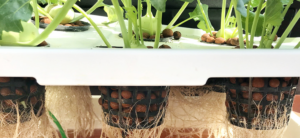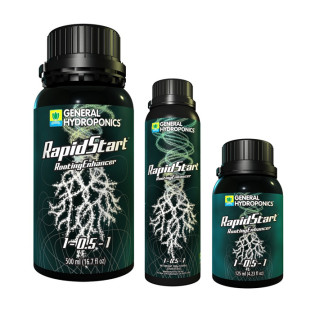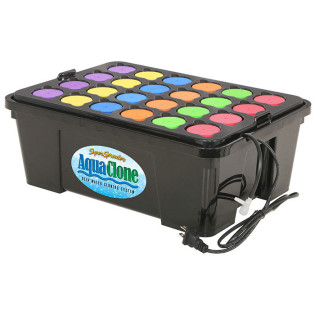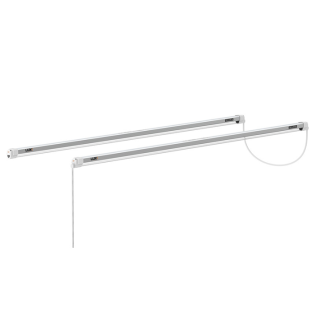
If you don’t already know how to use rooting hormone on cuttings, you are in for a treat today, because we are going to change your cloning & propagation process for good.
If you want your plants to get off to the right start, it’s up to you to provide them with what they need to thrive.
Water and sunlight - those are the two biggies, right? When you’re trying to propagate plant cuttings, those are important for sure.
However, many people neglect the importance of this product. If you’re curious about how to use rooting hormone on cuttings to improve propagation, you’ve come to the right place.
In this guide, we will tell you everything you need to know about the rooting process and hormones and how they can help you increase the likelihood of your plant’s success.
However, many people neglect the importance of this product. If you’re curious about how to use rooting hormone on cuttings to improve propagation, you’ve come to the right place.
In this guide, we will tell you everything you need to know about this product and how it can help you increase the likelihood of your plant’s success.
What Is Rooting Hormone?
Rooting hormone is a chemical product that stimulates and encourages root growth.
Normally used on cuttings, it’s designed to provide you with the best chances of success when you take a cutting from a plant and attempt to grow a new one that is identical to the parent plant.
This process of propagation is known as cloning a plant, and we have an entire guide on it if you’re a first-timer!
Using rooting hormones is a reliable way to propagate your favorite plants. When used properly, it helps a cutting develop roots more rapidly. Studies show that clones that had this product applied become stronger than cuttings that did not receive the hormone.
You can use it on root cuttings, stem cuttings, and leaf cuttings, and it can be found in gel, powder, and liquid forms. We’ll talk more about the different types in just a moment.
What Plants Can You Use Rooting Hormone On?

Many people use it on ornamental plants as well as succulents, although you can technically use rooting hormone on just about any plant you intend to grow from a cutting.
You can even use it on a variety of plant cuttings, including fresh growth, roots, leaves, and even woody stems.
It will boost your odds of propagation success. You can even use it on blooming plants as long as you allow the blooms to fade before you take your cutting.
There are some kinds of cuttings that will require you to use more rooting hormone than others. You can figure this out by examining the greenness of a stem.
The very top portion of a cutting is known as softwood, a piece that bends easily without breaking.
Softwood cuttings often don’t need hormones, since they are able to root in water alone. Most herbs provide softwood cuttings, including basil, lemon balm, and mint.
There are other plants (including some herbs) that produce stiffer cuttings. For example, rosemary and thyme produce hard brown stems. These may require more rooting hormone.
How To Use Rooting Hormone For My Propagation Process
Of course, you don’t have to use a rooting hormone when you are propagating new plants, but you would be wise to. It can ensure you have a great start to plant growth.
Using rooting hormones will help you increase your rooting success rate. This means the number of clones you get to take root and grow into large healthy plants of their own.
Most often, you won’t get 100% of your clones to take root. It’s a numbers game, which is why cultivars will take more cuttings than they plan on using. But with the right hormones, you can increase your success rate.
It also can dramatically speed up the process at which your plants take root - so you can get to harvest quicker. Starting clones vs starting seeds is a quicker process, but even cloning takes time.
With rooting hormones, root systems can begin in as little as a week. It makes the process quicker and more efficient. It is a smart product to invest in if you care about the vitality of your plants. A good root system is the base of your pyramid.
What Are The Different Types Of Rooting Hormones?
There are several kinds of rooting hormones you can use, including powder hormones, rooting gels, rooting solutions, and rooting sprays. All of these essentially do the same thing, but there are some key differences.
Rooting Gel
We recommend using a rooting gel if possible because it’s easy and mess-free. The main benefit of using a rooting gel is that it is convenient and requires no diluting.
It isn’t as messy as a powder and also offers a thicker coverage so it sticks better to plant tissue.
Rooting Powder
You can also use a powder. Powder rooting hormones are similar in consistency to talc powder (or flour) and are often used in commercial growing operations.
The powder is easy to use and does not require refrigeration. It also has one of the longest shelf lives of all rooting hormones. It is often viewed as less efficient than a liquid rooting hormone because it doesn’t stick as well to the cutting
Rooting Solution (Liquid Form)
A liquid rooting hormone, which can be purchased as a solution or a spray, is often used by homeowners. It can be purchased in a concentrated or standard strength. If you use a concentrated solution, you will need to dilute it first.
A liquid hormone will be much more convenient and less messy than a powdered type.
You can adjust the concentration to meet the needs of the plants you are rooting, too, making it more customizable. However, it often has to be refrigerated.
How To Use Rooting Hormone To Root Plants Quicker
You came here to learn how to use rooting hormone on cuttings, so let’s get into it! Although your strategies and techniques in applying the product will vary depending on what kind of plant you are growing, in general, there are a few quick tips you can follow.
Start By Taking Your Cuttings

Start by removing a fresh and healthy stem cutting from a mother plant with a sharp knife. Be sure to use clean tools to avoid contamination and only take cuttings from healthy, vigorous plants.
Remember that your clones will simply be replicated genetics from the mother plants, so you only want the healthiest candidates!
You will want to take a cutting from a growing tip that’s around three to eight inches long. Cut the top few inches from the stem, doing so near a node. Remove any flowers and leaves.
Apply Your Rooting Hormone To The Exposed Stalk

Immediately after taking your cutting, it’s time to apply the rooting hormone. The exact process depends on whether you’re using a gel or powder. For the sake of this article we’ll assume you’re using a gel since this is the easiest.
Put a bit of rooting hormone in a separate dish so you aren’t dipping stalks directly into the bottle. This will prevent cross-contamination from different plants or strains.
Dip the cutting into the rooting hormone. You don’t want to apply the rooting hormone any higher than the planting depth. This won’t necessarily hurt your plant, but it will be a waste of product.
Stick The Cutting In Your Cloning Machine Or Garden Pot

Once you have covered the cutting in rooting gel or rooting powder, it’s time to place it in either a cloning machine or a pot with media in it. It really depends on how you’re going to grow.
We recommend using a cloning machine, as this will greatly speed up the process and your chances of success. You can learn all about the best cloning machines in our blog post.
If you are foregoing the cloning system, plant your cutting in a soilless potting medium. You can make a hole with a pencil or a similar diameter tool.
The planting hole needs to be wide enough that your hormone does not get wiped off as you insert the cutting in the soil. Remove the air pockets around the cutting, tapping lightly, then water and keep the cutting warm. We recommend providing a light source, but nothing too crazy. Just a simple T5 fixture or low-wattage LED grow light will work perfectly.
Rooting A Leaf Cutting vs A Stem Cutting
If you plan on rooting a leaf cutting, you will need to apply the rooting hormone to the portion of the leaf. Make sure that is is closest to the center of the plant. This is something you might do if you are working with a plant doesn’t have a stem.
Cover it with some soilless potting mix and plant the leaf halfway down. If your leaf has a shorter stem, you can dip it in rooting hormone and plant it just like you would with a stem cutting.
Of course, you can always work with root cuttings, too. Root cuttings are pieces of the root that are used to eventually produce a new plant.
You can work with root cuttings by removing two-inch pieces of roots from the plant and then recovering the area of the parent plant. Roll the cutting in the rooting hormone, then plant shallowly in your medium.
Can You Use Too Much Rooting Hormone?
When it comes to using rooting hormone, there is such a thing as too much of a good thing. There’s also such a thing as too little.
When you are applying this product, you need to be more careful about using too little. If you use to little, it will produce no effect on the plant at all, and your money will be wasted.
Using too much is even more harmful, though. Think about it this way. Your hormones are nutrients, and we all know how easily plants can be burned by overfeeding nutrients!
It can cause the plant to wither and yellow.
What Are The Best Rooting Hormones To Use On Plants?
Using these products will speed up your germination process substantially. You will you need to be sure to use the best rooting hormones if you want the best results!We carry a wide range of options here at Hydrobuilder, and they really are all great choices. But we want to highlight a couple of products we’ve seen our growers get exceptional results with.
Clonex Rooting Hormones
One of the most popular rooting hormone brands on the market is Clonex. They are known for their rooting gel, but also offer:
- Rooting Spray
- Granular Mycorrhizae Rooting Hormones
- Rooting Solution
No matter which version of these products you opt for, Clonex Rooting Hormones provide more efficient rooting at an affordable price.
General Hydroponics Rapid Start
An awesome rooting hormone powder product is General Hydroponics Rapid Start.
This brand is as good as it gets when it comes to horticulture supplies and plant nutrients. So, it should come as no surprise that Rapid Start is one of the best root stimulating hormones on the market.
Specifically, this product does a better job of promoting fine root hairs and lateral root branching. This in turn produces a bigger, heavier plant.
To get the most out of this product, continue using it through veg and early flower along with your regular feedings. The bigger the root, the bigger the fruit!
Final Thoughts On How To Use Rooting Hormone
Ready to start shopping for rooting hormones? You’ll want to weigh the various pros and cons of each type of rooting hormone. This will help you to decide whether a powder, liquid, or gel is right for you.
Other than that, you’ll find rooting hormones of all shapes, sizes, and prices. You should be sure to shop around to find the one that’s perfect for your plants.
When you're shopping for rooting hormones, there’s no better place to look than Hydrobuilder.
At Hydrobuilder, we offer the widest selection of rooting hormones around. We also offer the service and knowledge to help you tackle any home or commercial gardening project.
We have all kinds of rooting hormones and other tools to make your plant propagation project a success. Shop now for the best selection and the best prices.







































